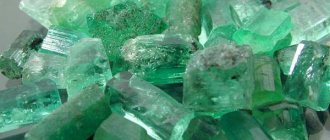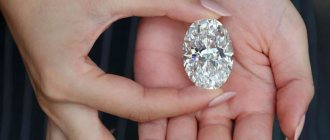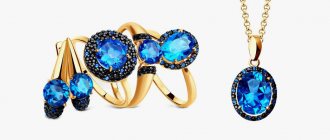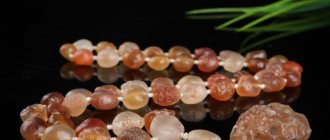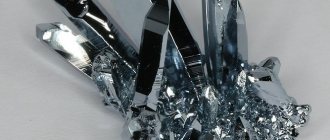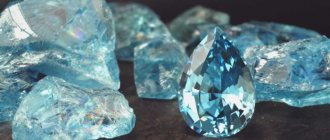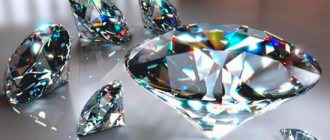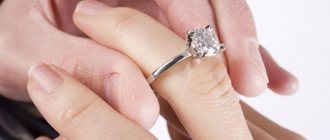In the jewelry industry, orange stones are often used - precious and semi-precious, and in the production of costume jewelry - ornamental ones. The color palette of fire gems is varied: from light orange to bright and deep honey with a red or brown tint. Orange stone is associated with sunlight, warmth, and also gold. Some of them have been known since ancient times, while others became popular only in the 20th century.
Assortment of minerals
The list of names for orange stones is shorter compared to minerals of other colors. But here there are natural stones of all jewelry categories.
Gems
Among precious gems, rare varieties of diamond and sapphire are endowed with a solar color.
Diamond
Orange gem number one. Occurs one in a million (in carats). Mined only in Central and Southern Africa, Australia (Argil mine). The color is created by the nitrogen in the structure.
Diamond
The cost of a stone smaller than a carat is $40 thousand per carat. Stones larger than five carats are counted in only a few and are sold only at auctions such as Sotheby's.
The most popular member of the family is the Pumpkin diamond. The owner christened it this way for two reasons: the rich coloring plus the date of purchase on the eve of Halloween. In 1997, Ronald Winston bought a 5.54-carat diamond for $1.3 million. Today its price is $3 million.
Sapphire
Sapphire, the color of lotus petals - orange-pink - is one of the rarest. This expensive variety is called Padparadscha, which means "lotus" in Sinhala (one of the languages of India). She is held in special esteem in the country.
Sapphire
There are bright or yellow-orange stones.
Padparadscha is more expensive than sky-blue Kashmir stone ($7-10 thousand per carat). Extracted only in Sri Lanka.
Semi-precious
The most extensive segment. Some names are included here on a formal basis, since sometimes an orange semi-precious stone can compete in beauty and price with a precious one.
Heliodor
The transparent semi-precious stone, whose name means “gift of the Sun,” was discovered two hundred years ago. Color range with colors from light gold to dark honey.
Heliodor
Specimens with orange tints are among the rarest and most valuable.
Pomegranate
Orange tones and shades are present in two types of stone:
- pyrope – fiery or violet-red, orange with a variable shade;
- Spessartine is a pink, yellow-brown, yellow-orange stone.
Video: expressive orange Fanta spessartine.
Classified as average in price among garnets.
Pomegranate
Opal
Noble and simple opals have orange shades.
Fiery. Transparent or translucent noble mineraloid of fiery orange shades. Varies by place of extraction:
- Brazilian opal is translucent, the hardest due to its low percentage of water;
- Australian – bright orange with a reddish tint;
- Mexican - specimens with opalescence.
Beautiful fire opal
Among simple opals, orange is considered the Rainbow mineral - a stone with a 3D color effect. The second name is Ethiopian, after the country of production.
Simbirtsit
The stone is a conglomerate of limestone, pyrite, marl, calcite and the remains of ancient marine fauna. In nature, there are brown, orange, green, and white specimens. There are vein and ammonite simbircite. The first variety is mined in Russia and Argentina, the second only in Russia (Simbirsk region). An artificial mineral was also created here.
Simbirtsit
Topaz
Transparent orange topaz is called Korolevsky. The second name of the variety is Imperial. No color standard has been developed, but most gemologists and jewelers consider the orange-brown color scheme to be the standard.
Spanish topaz
Citrine
In nature, this variety of quartz is light yellow. Bright orange shades are obtained as a result of heat treatment of crystals. Such specimens are called “Madeira” - due to their similarity to the corresponding type of wine. Despite their partial artificial origin, they are more expensive than unprocessed ones - from $15 per carat.
Beads made from natural citrine stone
Ornamental
These types of orange stones compensate for their opacity and lack of bright shine with optimistic colors and affordable prices.
Coral
Red-orange specimens are part of the group of red corals classified as noble. The orange variety is called "salmon".
Bracelet with orange coral
Cornelian
The usual color of the stone is yellow-honey. Orangeness is seen in the following varieties:
- carnelian – rich red, thick red-orange;
- carnelian – orange-red, orange-yellow with pinkish hues.
Carnelian beads
The first, darkish variety is considered male, the second (light) is considered female.
Often the orange color is diluted with black, white or gray veins.
Sardonyx
This is the name given to agates with veins of red, carmine, yellow and orange colors. The layers form bizarre shapes and patterns on the cut. Valued for its decorativeness.
Sardonyx
Eye of the Tiger
An orange background is not often found in this mineral, but is more often brownish-yellow. The more valuable it is. It is distinguished by its silkiness and iridescence with sparkles, which are especially visible in the sun.
Tiger's Eye Quartz
Amber
Orange is one of the classic amber shades.
Amber
Minerologists distinguish the following varieties of this color:
- bokkerite – dense opaque reddish;
- shraufite – translucent yellow-red, red.
Both are considered jewelry, high quality, and are mined mainly in the Baltic.
Jasper
The most popular ornamental stone. Orange jasper is one of the most beautiful in its family. Opaque monochrome and patterned specimens are equally good.
Jasper jewelry
Origin story
Painite stone
The history of the stone began in the mid-20th century. In 1956, British scientist Arthur Payne discovered three amazing orange-brown crystals in the mountains of central Myanmar (formerly Burma). Over the next 49 years, despite all the efforts of prospectors in the search, these were the only specimens of painite. Only by 2005, after a thorough study of the lands of Burma, about 25 more painite crystals were discovered, which were immediately distributed to private and museum collections.
“painit” received its name in honor of its discoverer Arthur Payne. In Russian, the stone is called “painite” or “painite”. Today, painite is listed in the Guinness Book of Records as the rarest mineral on the planet.
Decorations
Solar minerals are loved by jewelers and stone cutters:
- Pebbles of any transparency are used.
- Jewelry with orange stones looks good in gold. A budget solution - in silver or yellow jewelry alloy.
- A light pendant, pendant, bracelet made of carnelian or amber will be suitable as the first gift for a little fashionista.
- You need to care for stones of these shades in the same way as other representatives of a particular species.
An additional advantage of orange is that it is appropriate for people of any age. Even men can choose a subdued and noble option for cufflinks or signet rings.
Moderately shiny decorative specimens are in demand for decorating premises, making small plastic items, desk writing instruments, and other interior items.
Areas of application
Until recently, the only area of application for painite was collecting. The first 25 specimens of this rare mineral are found mainly in private collections. Stones of lower quality found later in most cases do not attract the attention of collectors, but are in demand among jewelers.
The owners of single faceted specimens of painite are known by name. Such samples have an exorbitant cost, hundreds of times higher than the price of diamonds.
Magic properties
The main mission of such stones is to attract luck to the owner, lift spirits, and strengthen the family.
But the meaning of orange is broader; each pebble also helps in its own way:
- Heliodor calms nerves and relieves tension. Able to attract love and make the owner a lucky optimist.
- Pomegranate. Orange stones, unlike red ones, balance the senses and mind. Especially useful for girls. It is a traditional symbol of fidelity and is therefore ideal for couples.
- Opal. The fiery variety makes men more masculine and women more feminine.
- Sapphire. Padparadscha acts as an amulet against love spells and a talisman to attract the attention of the desired person (especially earrings). Strengthens the family hearth and is able to restore trust.
- Cornelian. Makes a person sexually attractive, but not susceptible to unwanted advances. A ring with a stone helps you get pregnant, a bracelet will make you more confident and stronger.
- Simbirtsit relieves tension and helps to remain calm. Helps you concentrate, absorbs radiation from gadgets. The main advantage of esotericism is the huge energy intensity of the stone. He shares it with a person, endowing him with vitality and energy.
- The tiger's eye will strengthen you physically and make the owner of the jewelry a sage, a clairvoyant. Will protect you from recklessness in words and deeds.
- Imperial topaz supports the activity of the right hemisphere of the brain. And this is a direct path to unlocking a person’s creative and business potential.
- Citrine in the form of a pendant is very useful for timid people. They will become more confident and relaxed.
- Amber will help the owner activate extrasensory abilities, make him luckier, and add optimism.
- Jasper resets the negativity accumulated over a lifetime.
Any jewelry with an orange stone will make the owner richer.
Therapeutic effect
The orange stone strengthens the immune system and heals the body as a whole. The individual healing properties of orange minerals have been revealed:
- Heliodor heals the heart.
- Pomegranate treats pulmonary diseases (pendant, brooch). The bracelet solves throat problems.
- Corals. Removes toxins, cleanses the blood, strengthens vision and memory. Used as a remedy for “nerves”: tics, insomnia, depression. The throat or acute respiratory infections are treated with coral beads. They are useful for everyone who makes money with their voices: announcers, singers, lecturers.
- Opal. The fiery variety is a stimulant of vital energy, necessary for people who are weakened or lethargic from birth.
- Sapphire. Padparadscha strengthens the immune system, provides a shield to viruses, treats the heart and skin diseases.
- Cornelian. A heated stone heals inflamed joints and lymph nodes. Short beads are worn for diseases of the thyroid gland. It is recommended to keep the pebble in the mouth during childbirth. Its properties are recognized by official medicine: doctors believe that microdoses of radioactivity activate the body’s potential.
- Simbirtsit. Treats the gastrointestinal tract and joints. Powder is used to sprinkle on wounds, eczema, and other skin rashes.
- Topaz normalizes sleep, relieves depression, and neutralizes even strong aggressiveness.
- Citrine is recommended for anyone who has trouble sleeping. It is enough not to take off the ring with the stone at night.
- Amber. Heals the entire body (pebbles are applied to the desired area or jewelry is worn). If dizziness or tingling occurs at the application sites, they are removed. The strongest are dark orange of medium size.
- Jasper. Replenishes energy reserves and rejuvenates the skin.
Natural stones in jewelry are indicators of the owner’s health. If during wearing the surface becomes covered with cracks or stains, you need to be examined.
Spessartine
Orange garnet (spessartine) is a manganese-aluminum silicate. It is mined in the USA, Pakistan, Nigeria, Mozambique, Namibia, Tanzania, and Madagascar. In Russia, spessartine is found in the Middle Urals, the Kola Peninsula, and Karelia.
Orange spessartine enhances sexual energy
A rare variety of natural mineral is used as a jewelry stone and as an investment item. Some orange gem-quality minerals have trade names:
- Kashmir (Pakistan);
- mandarin (Namibia);
- Fanta (Namibia).
Manganese gives the stone its fiery hue. The samples obtained in Nigeria, Zambia, and the USA have the highest concentrations. The formula of spessartine is Mn₃Al₂(SiO₄)₃, hardness is 6.5-7, structure is broken, conchoidal.
Famous jewelry brands have appreciated the beauty of orange garnet. Earrings and rings with cushion and pear cuts from Louis Vuitton, Harry Winston, Tiffany & Co, Van Cleef & Arpels are successfully sold at world auctions. Pure specimens of 5.44-23.6 carats cost 100-300 thousand rubles. Cut: oval, cabochon, cushion, heart.
Orange stones and Zodiac
Among the sunny red stones there is a suitable option for each zodiac sign:
- diamond - Leo;
- pomegranate – Gemini, Scorpio, Capricorn, Virgo;
- coral - everything except Virgo and Capricorn;
- sapphire - everything except Pisces and Libra (decoration only) Capricorn (antagonists);
- carnelian - everything except Scorpio;
- simbirtsit - everything, but the favorites are Leo and Taurus;
- topaz – Leo, Gemini, Aries;
- citrine – “earthly” signs;
- jasper - Virgo; Gemini and Aries do not need it.
Opal is universal, that is, it suits everyone according to the Zodiac.
